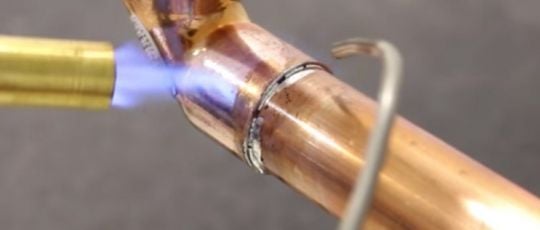Key Steps for Copper Pipe Soldering

Here we look at the key steps and best practice for soldering copper pipes. From preparation such as cutting, cleaning and applying flux to the actual heating and soldering process.
We also highlight the key materials you will need along the way.
Step 1: Cut Pipe to the Required Length
The best method for ensuring a neat clean cut is to use a ‘Tube’ Cutter or Pipe Slice, simply place the chosen cutter around the pipe and tighten / clamp into position via the cutting wheel and roller. Although pipe cutters can come in different sizes the principle is the same, rotate the cutter around the pipe until it loosens, retighten the cutter and then continue to rotate and retighten until the pipe is cut.
The cutting wheel will produce a small lip on the inside of the pipe, so it’s good practice to remove this with a deburring tool (often included on larger cutters) to prevent any undesirable turbulence or sediment build up.
Step 2: Clean the Pipe and Fitting
For a quality soldered joint it’s imperative the pipe and fitting is clean and shiny, to achieve this you can use a steel brush, pipe cleaning and polishing strips, steel wool or an emery cloth to remove the oxide surface layer. For cleaning fittings there are specialist steel brushes, alternatively pipe polishing strips and emery cloths can easily be rolled up to fit inside and rotated for a thorough clean.
Step 3: Apply Flux to the Pipe and Fitting
After cleaning, apply a thin layer of flux using a flux brush to where the joint will be formed on the pipes and fittings before sliding together. As solder can’t be applied directly inside the joint the flux will help draw the solder into the joint through capillary action to ensure a strong connection between pipe and fitting. Some flux such as Fry Powerflow offer good penetration of surface oxide so no pre-cleaning is actually required. If flux isn’t applied then the solder will only form a superficial layer at the entrance of the joint which can lead to leaking pipes in the future. If too much flux is applied then excess flux can get inside the pipe which can lead to pitting and pin hole leaks.
Step 4: Prepare the Soldering Area
Clear the area allocated for soldering as much as possible, plus to help reduce the risk of fire use a heat mat to protect any remaining flammable materials. It’s good practice to cut, clean, flux and assemble a group of pipes and fittings to be soldered. As having the pipes already in position allows for easy soldering of one joint after another, whilst cutting down on disturbing the joints before they’ve cooled.
Step 5: Heat the Pipe Joint / Fitting
Soldering copper pipe requires high intensity heat, apply heat evenly around the fitting, using a self-lighting brazing torch. You can use either Propane Gas or MAPP Gas, with MAPP Gas producing a hotter flame, that is better for soldering larger diameter pipes.
It’s best to start heating from the bottom of the joint as the heat will rise, plus if you start at the top when the solder melts it will run down and have nowhere to go as the bottom of the joint might not be hot enough to draw it in.
Applying the right amount of heat comes with practice, if there isn’t enough heat the solder wont flow into the joint, if the joint is heated for too long the flux will burn, start to smoke and blacken, again preventing the solder from flowing into the joint.
Step 6: Apply the Solder to the Pipe Joint
First choose a lead-free solder that complies with BS EN ISO 9453:2020 and is compatible for use with potable water applications.
Lay the solder on the joint in between heating until the solder begins to melt. Then liberally apply the solder once it begins to melt easily, reheating to help pull the solder into the joint. If you notice an area that needs more solder, whilst still warm brush a little more flux onto it which should melt and flow into the gap, allowing you to reheat and apply more solder. To ensure a joint is completely filled, quickly run the tip of the solder around the seam of the joint. Bending the solder to create a hook, will allow easy reach of the underside of the joint.
When there is a silver band that’s flush with the pipe surface around the entire joint enough solder has been applied. However, take care not to apply too much solder, as this can cause a solder bubble on the lower part of the joint, although this doesn’t necessarily affect the joint it doesn’t leave the desired clean finish. So where possible clean off any drips.
Note if soldering several fitting joints close together, such as a T or angle fitting be aware that the heat intended heat for one joint can soften the solder on an already completed joint. To help prevent joints from coming apart, keep the adjacent joints being soldered in a horizontal position.
Check out our Soldering and Brazing range along with our PPE range, alternatively you can contact our sales team on 01322 274226 or [email protected] to discuss your specific requirements.












